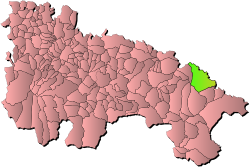Calahorra
Calahorra, (pronounced [kalaˈora]), La Rioja, Spain is a municipality in Rioja Baja. It is near the border with Navarre on the river Ebro. During ancient Roman times, Calahorra was known as Calagurris Fibularia.
 Location within La Rioja | |
| Coordinates: 42°18′00″N 1°58′00″W / 42.30000°N 1.96667°WCoordinates: 42°18′00″N 1°58′00″W / 42.30000°N 1.96667°W | |
| Country | Spain |
| Autonomous community | La Rioja |
| Comarca | Rioja Baja |
| Area | |
| • Total | 93.57 km2 (36.13 sq mi) |
| Elevation | 358 m (1,175 ft) |
| Population (2009) | |
| • Total | 24,787 |
| • Density | 264.903/km2 (686.10/sq mi) |
| Time zone | UTC+1 (CET) |
| • Summer (DST) | UTC+2 (CET) |
Location
The city is located on a hill at an altitude of 358 metres (1,175 ft) at the confluence of the Ebro and Cidacos rivers. It has an area of 91.41 square kilometres (35.29 sq mi). Calahorra is the second-largest city in La Rioja in population and importance. 21,060 people live there.
History
People have lived in the area that is now Calahorra since the Paleolithic. It has had a stable population since the Iron Age.
Rome took control of the town in 187 BC. They made it more important as an administrative centre for regions near it. Julius Caesar and Augustus Caesar gave the city (then named Calagurris) converted the town into a municipality. They developed its city planning, economy, and politics. Its archeological remains show that it had a circus, baths, an amphitheatre, and other things found in large cities. It minted money and served as a justice administration centre.
After the rule of the Moors in the 9th and 10th centuries the Christian king García Sánchez III of Navarre captured the city in 1045.
Twin cities
Gallery
Other websites
| Wikimedia Commons has media related to Lua error in Module:Commons_link at line 62: attempt to index field 'wikibase' (a nil value).. |




